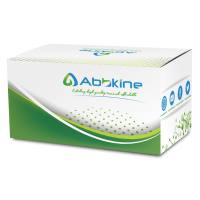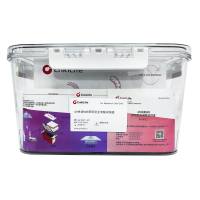SDS PAGE and Western Blotting
互联网
Conduct SDS-PAGE according to standard procedures.
1. Cast gel and allow to polymerize
2. Prepare samples to be resolved
3.Load gel
4.Run gel (< 200 volts for ~ 1 – 1.5 hours)
Transferring proteins to nitrocellulose membrane.
Can either use “wet” or “semidry” apparatus.
Wet transfer:
1.Disassemble gel casting plates so the gel is flat on one side or the other.
2.Using a clean razor, remove the stacking gel and clip the top right corner of the blot (according to the loading).
3.Using gloved hands and tweezers, quickly cut a piece of nitrocellulose to the same size of the gel.
4.Pre-wet both the gel and nitrocellose in transbloundefined buffer
5.Cut four pieces of Whatman paper to the size of the nitrocellulose.
6.Assemble the ‘sandwich’ as below make sure the cassette is open with the black side down before assembly!
a.Wet and place a Dacron pad nearest the hinge
b.Wet two pieces of Whatman paper, place on the Dacron pad
c.Put gel right-side-up and back-to-front on the filter paper
d.Place pre-wet nitrocellulose on top of gel, matching the clipped edge of gel with the clipped edge of the nitrocellulose
e.Place two more pieces of wet whatman paper onto the filter
f.Wet and place the other Dacron pad on the top.
g.Close and lock the cassett, place it into the electrode cassette and cover with transbloundefined buffer.
h.Add a stir bar and ice pack, and start transfer
7. Time and voltage of transfer will vary depending on the properties of the protein and the transbloundefined buffer used.
Continuous Semidry Transfer:
1. Disassemble gel-casting plates so the gel is flat on one side or the other.
2. Using a clean razor, remove the stacking gel and clip the top right corner of the blot (according to the loading).
3. Using gloved hands and tweezers, quickly cut a piece of nitrocellulose to the same size of the gel. (measure the gel area in centimeters)
4. Pre-wet both the gel and nitrocellose in transbloundefined_buffer~1~0~0~0~0~Kbr_~H~M~1~0~0~0~05._Cut_16_pieces_of_Munktell_Grade_1F_filter_paper_to_the_size_of_the_nitrocellulose.~1~0~0~0~0~Kbr_~H~M~1~0~0~0~06._Assemble_the_apparatus_as_follows~I~1~0~0~0~0~Kbr_~H~M~1~0~0~0~0a._Soak_8_pieces_of_filter_paper_in_trasbloundefined_buffer_and_make_sure_they_are_air_bubble_free_on_the_anode_plate.~1~0~0~0~0~Kbr_~H~M~1~0~0~0~0b._Place_the_pre~Fwet_nitrocellulose_filter_onto_the_stack~1~0~0~0~0~Kbr_~H~M~1~0~0~0~0c._Place_the_pre~Fsoaked_gel_onto_the_nitrocellulose~1~0~0~0~0~Kbr_~H~M~1~0~0~0~0d._Place_8_more_soaked_pieces_of_filter_paper_on_the_gel.~1~0~0~0~0~Kbr_~H~M~1~0~0~0~0e._Purge_the_stack_of_any_air_bubbles_with_a_glass_pipette.~1~0~0~0~0~Kbr_~H~M~1~0~0~0~0f._Assemble_the_cathode_plate_and_start_the_transfer~1~0~0~0~0~Kbr_~H~M~1~0~0~0~07._The_equation_to_calculate_the_amperage_for_a_1_hour_transfer_is~I~1~0~0~0~0~Kbr_~H~M~1~0~0~0~0a._0.8_mA_~H_cm~1~0~0~0~0~Ksup~M2~K~Hsup~M~1~0~0~0~0gel.~1~0~0~0~0~Kbr_~H~M~1~0~0~0~08._After_1_hour~E_disassemble_apparatus_and_western_blot_the_membrane.~1~0~0~0~0~Kbr_~H~M~1~0~0~0~0~Kbr_~H~M~1~0~0~0~0For_discontinuous_semidry_transfer~E_see_the_LKB_2117_Manual_for_appropriate_reagents_and_assembly_conditions.~1~0~0~0~K~Hp~M~1~0~0~0~Kp~M~1~0~0~0~0Western_blotting.~1~0~0~0~0~Kbr_~H~M~1~0~0~0~01._Disassemble_transfer_apparatus_and_remove_the_filter_~Amembrane~B_from_the_sandwich.~1~0~0~0~0~Kbr_~H~M~1~0~0~0~02._Rinse_the_filter_twice_for_5_minutes_with_TBS_or_TBS~F0.1~7_Tween~F20_~PFor_most_applications~E_TBS_can_be_interchanged_with_PBS_for_all_washes_and_incubations~E_pending_you_are_consistent_with_one_or_the_other_throughout~Q.~1~0~0~0~0~Kbr_~H~M~1~0~0~0~03._Block_the_filter_in_a_solution_of_TBS~FT~E_5~7_non~Ffat_dry_powdered_milk_~Aw~Hv~B_for_at_least_1_hour_at_room_temperature_~Aor_overnight_at_4_degrees~B.~1~0~0~0~0~Kbr_~H~M~1~0~0~0~04._Add_primary_antibody_to_the_blocked_filter_at_the_appropriate_dilution_and_place_in_a_seal~Fo~Fmeal_bag_without_air_bubbles.~1~0~0~0~0~Kbr_~H~M~1~0~0~0~05._Incubate_primary_antibody_the_appropriate_time_and_temp.~1~0~0~0~0~Kbr_~H~M~1~0~0~0~06._Wash_the_filter_at_least_three_times_for_five_minutes_each_in_TBS~FT~1~0~0~0~0~Kbr_~H~M~1~0~0~0~07._Optional~I_Reblock_the_filter_after_primary_antibody_for_10~F30_minutes.~1~0~0~0~0~Kbr_~H~M~1~0~0~0~08._Apply_the_appropriate_HRP~Fconjugated_secondary_antibody_~Adiluted_in_blocking_solution~B_to_the_filter_for_at_least_1_hour_at_room_temperature.~1~0~0~0~0~Kbr_~H~M~1~0~0~0~09._Wash_the_filter_at_least_three_times_in_TBS~FT_~A5_– 10 minutes each)
10. Wash the filter once in TBS.
11. Develop the blot using chemiluminescence (ECL) substrates.
Developing the blot using PIERCE Chemiluminescence substrates (Supersignal).
1. Mix equal parts of “stable peroxide solution” (white bottle) and “luminol solution” (brown bottle). For a minigel filter, 5 ml of each is ample in a square petri dish.
2. Mix by swirling and allow the solution to come to room temp (~ 5 minutes)
3. Incubate washed filter with developing solution for 1 minute, swirling constantly and keeping filter covered with solution.
4. Optional: Rinse filter with TBS
5. Place filter face down on a piece of saran wrap, and fold edges under to seal the filter
6. Place the wrapped filter into an X-ray film cassette and tape edges to hold in place.
7. In the dark room, expose film to the filter and develop using the automatic film processor.
8. In ambient light, mark the position of the mw markers on the autorad using a marker. The tape marks on the autorad can be used to align the filter with the autorad.








